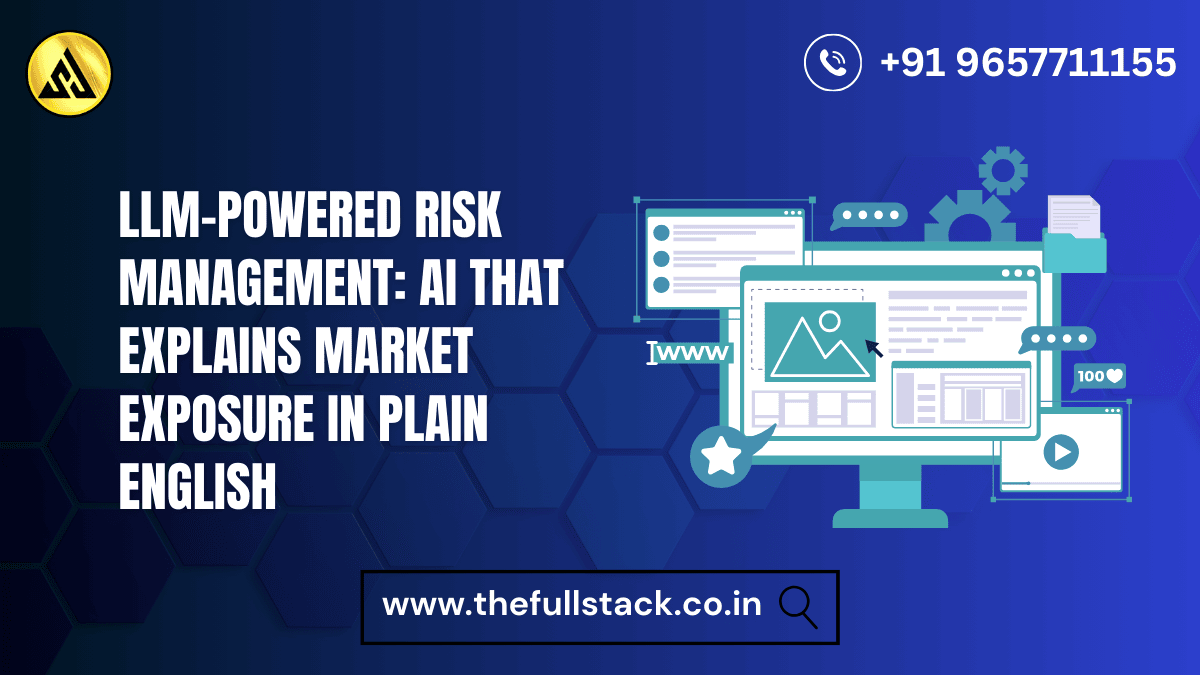
LLM-Powered Risk Management: AI That Explains Market Exposure in Plain English
Financial risk is something every investor encounters, but few truly understand. Reports are often filled with technical terms, mathematical models, and charts that make sense only to seasoned analysts. For beginners or even company employees outside of finance, this complexity can feel overwhelming.
But imagine if risk could be explained in everyday language—clear, simple, and easy to act on. This is the promise of LLM-powered risk management, where Large Language Models (LLMs)—the same type of AI that powers conversational tools—are applied to explain market exposure in plain English.
This technology is not just about crunching numbers. It’s about making risk management accessible to everyone, from new investors learning the basics to professionals who want clear, fast insights.
What Is Market Exposure?
At its core, market exposure is the measure of how much your portfolio is affected by changes in the market.
- If you invest mostly in technology stocks, your portfolio is highly exposed to the tech sector.
- If you spread investments across stocks, bonds, and commodities, your exposure is more balanced.
Market exposure tells you where your portfolio is vulnerable. Understanding this helps you avoid putting all your money in one place—a key principle of smart investing.
The challenge is that exposure is usually explained through terms like beta, correlation, or value at risk (VaR). These concepts, while useful, often confuse beginners.
Enter Large Language Models (LLMs)
LLMs are advanced AI systems trained to understand and generate natural human language. They can read technical data and translate it into explanations that anyone can follow.
In risk management, LLMs act like interpreters. Instead of showing you pages of graphs, they can say things like:
“Your portfolio is mostly invested in tech stocks. If the tech sector falls by 10%, your portfolio could lose about 7%. To lower this risk, you might add bonds or energy stocks.”
This turns abstract numbers into clear, relatable insights that empower you to take action.
How LLM-Powered Risk Management Works
The process behind the scenes looks like this:
- Collect Data – The AI pulls in market information, portfolio details, and economic signals.
- Analyze Risk – Traditional risk models calculate exposure and volatility.
- Translate Findings – The LLM converts technical results into plain English explanations.
- Provide Insights – You receive clear recommendations that highlight risks and possible solutions.
This way, you don’t just see “your beta is 1.4.” Instead, you learn that “your portfolio is 40% more volatile than the market.”
Why Beginners Should Care
For new investors, the hardest part of finance is the language barrier. Terms like “correlation coefficients” or “systematic risk” can discourage people from learning. LLM-powered tools lower this barrier by making risk:
- Understandable – No need for a finance background.
- Relevant – Insights connected directly to your portfolio.
- Actionable – Suggestions on what to do next, not just data.
This makes risk management more approachable and encourages better decision-making right from the start.
Market Trends and Industry Insights
- AI Adoption: Financial firms are increasingly using AI to improve clarity and efficiency.
- Regulatory Support: Regulators encourage plain-language reporting for investors, aligning perfectly with LLM-powered tools.
- Retail Accessibility: Everyday investors now have access to AI-driven platforms once limited to professionals.
These trends show that risk explanation in plain English is not just a convenience—it’s becoming an industry standard.
Real-World Applications
- Investment Apps
Retail platforms can use LLMs to help users understand risks without financial jargon. - Corporate Finance Teams
Employees can quickly summarize risk reports for managers who don’t have time for technical details. - Wealth Management
Advisors can explain exposure to clients in ways that build trust and confidence. - Education
Beginners can use AI-based risk tools as a learning aid to gradually build financial literacy.
Practical Tips for Beginners
Here are some steps if you want to start exploring LLM-powered risk tools:
- Ask Simple Questions: Use plain English queries like, “What’s the biggest risk in my portfolio?”
- Focus on Learning: Use the explanations as a way to understand key financial concepts over time.
- Test Safely: Start with demo accounts or small investments before relying heavily on AI suggestions.
- Stay Updated: Keep track of how AI tools evolve in finance—they’re improving rapidly.
- Take Courses: Structured learning will help you go beyond explanations and build deeper skills.
Why It Matters for Your Future
At the end of the day, risk management is about protecting your financial future. If you don’t understand your exposure, you could be making decisions in the dark.
By using LLM-powered tools, you gain:
- Clearer understanding of where your money is at risk.
- Guidance on how to diversify effectively.
- Confidence to make informed decisions without needing advanced finance knowledge.
For beginners, this is a way to start your investment journey with clarity. For professionals, it’s a tool to communicate risk better and faster.
Call-to-Action
The future of finance isn’t just about faster trades—it’s about smarter understanding. LLM-powered risk management puts knowledge into plain English, making markets more accessible to everyone.
👉 Ready to take your first step? Explore our advanced learning resources and courses on AI in finance, available on our website. Build the skills you need today to secure a stronger financial future tomorrow.
You also like this:-


Leave a Reply